Samaaro + Your CRM: Zero Integration Fee for Annual Sign-Ups Until 30 June, 2025
- 00Days
- 00Hrs
- 00Min
In the realm of event marketing, email is still a key strategy for engaging attendees, increasing registrations, and delivering a great experience for attendees. As we enter 2025, we will see the prominent use of trigger-based emails by marketers to communicate with their audience. Trigger-based emails are automated, action-based emails, that will allow your emails to reach the right people at the right times, which will improve productivity and results.
This guide discusses the basics of trigger-based emails, offering tips and examples to help you succeed in using a strong marketing tactic.
Trigger-based emails are an email marketing strategy that utilizes automation to deliver very targeted and personalized emails. Trigger-based emails are sent automatically based on certain actions, activities, or rules you define, helping to ensure the emails are relevant and meaningful to recipients. Triggered emails are a step above a traditional email blast that sends the same messaging to a long list of attendees with no real focus. Auto-actioned emails are specific and contextual, which empowers the deliverability of the action.
Trigger-based emails function by tracking user’s interactions or any other milestone with the appropriate output. For example:
The beauty of trigger-based emails lies in their alignment with the recipient’s journey. Here’s why they stand out:
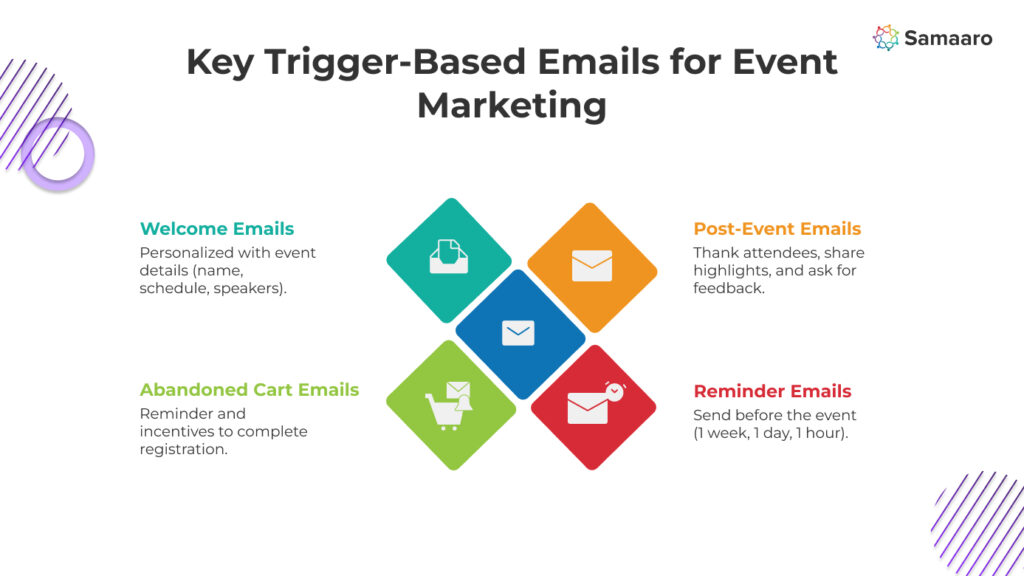
To illustrate their potential, here are some practical examples:
In the dynamic world of events, timing and communication are critical to success. Trigger-based emails ensure that every touchpoint, from registration to post-event follow-up, is strategically aligned with the attendee’s needs. Whether boosting registrations, reducing cart abandonment, or fostering post-event loyalty, trigger-based emails are a vital tool in any event marketer’s arsenal.
By leveraging trigger-based emails, you can transform your email marketing strategy into a personalized, automated, and highly efficient system that builds stronger connections with your audience while driving measurable results.
Welcome emails play a vital role in setting expectations and providing attendees with the information they need to start their event journey. They establish a positive first impression and ensure attendees feel valued.
When Triggered: Upon registration or ticket purchase.
What to Include:
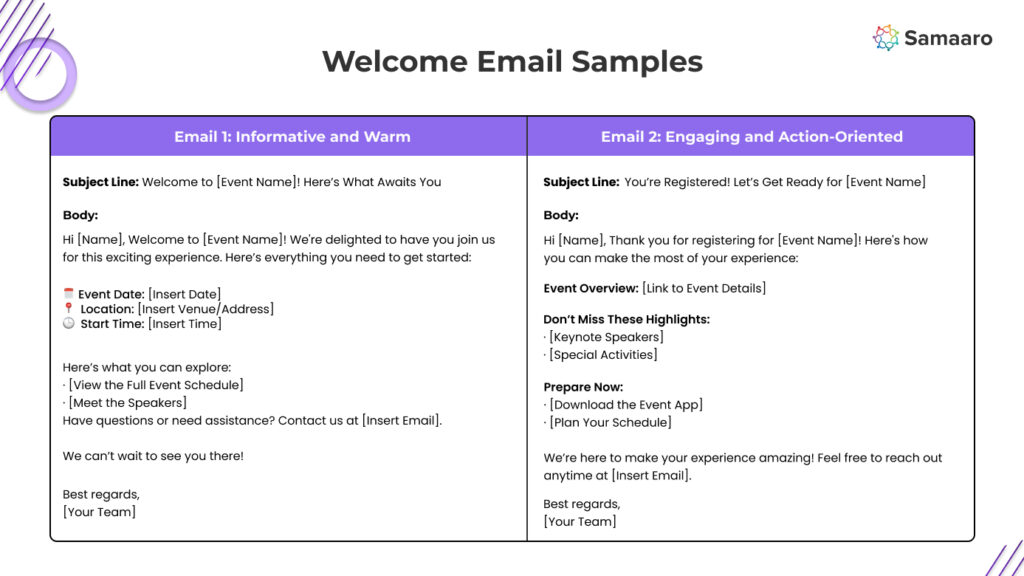
Cart abandonment emails are a gentle nudge to remind potential attendees to complete their ticket purchase. These emails should highlight the value of the event and create urgency to encourage action.
When Triggered: When a user leaves items in their shopping cart without completing registration.
What to Include:
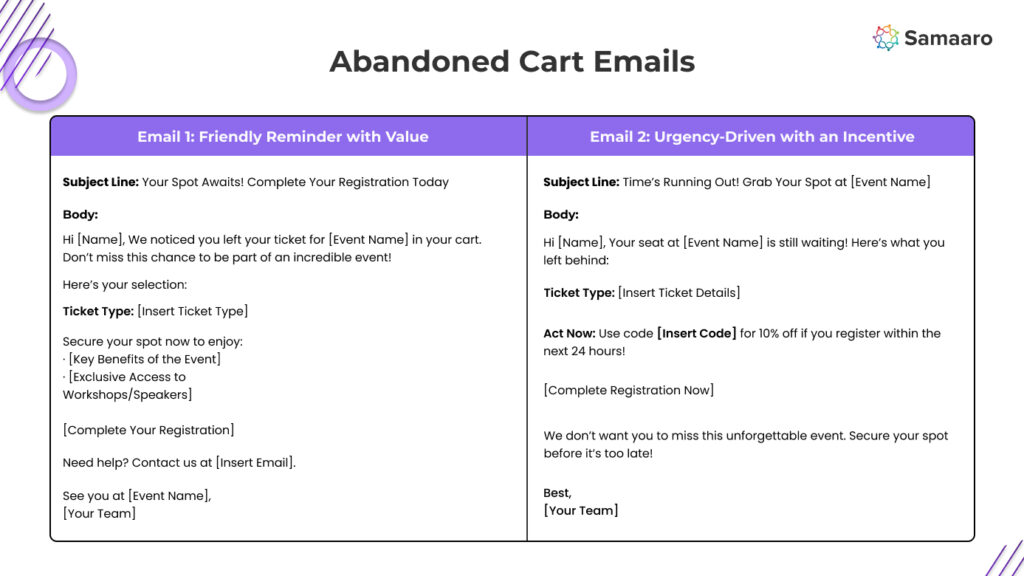
Reminder emails keep attendees informed and excited as the event approaches. These emails ensure attendees are well-prepared and don’t miss out.
When to send: 1 week, 1 day, and 1 hour before the event.
What to Include:
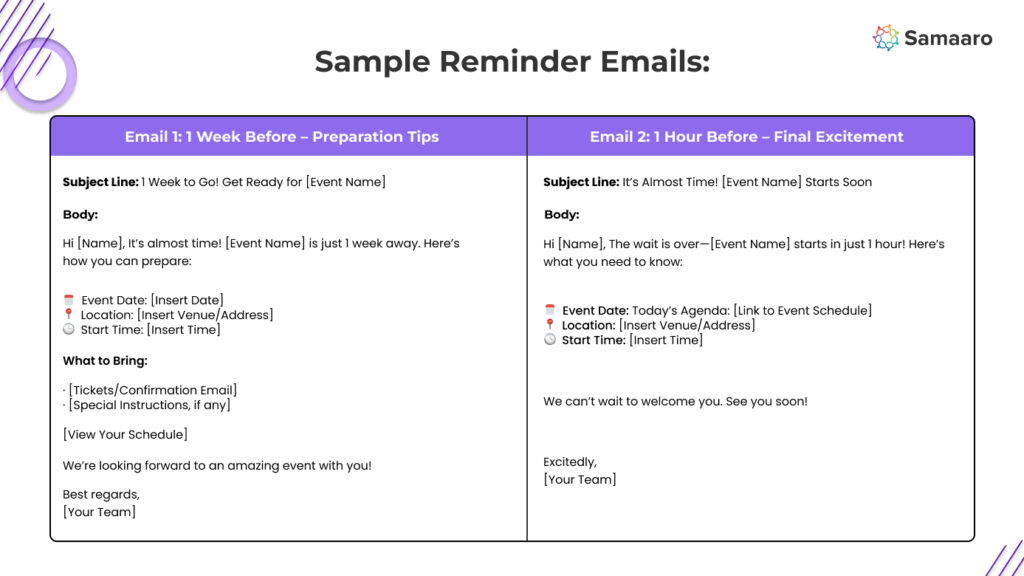
Post-event emails allow you to thank attendees, share highlights, and gather valuable feedback. They’re also an excellent opportunity to nurture relationships and promote future events.
When to send: Within 24–48 hours after the event.
What to Include:
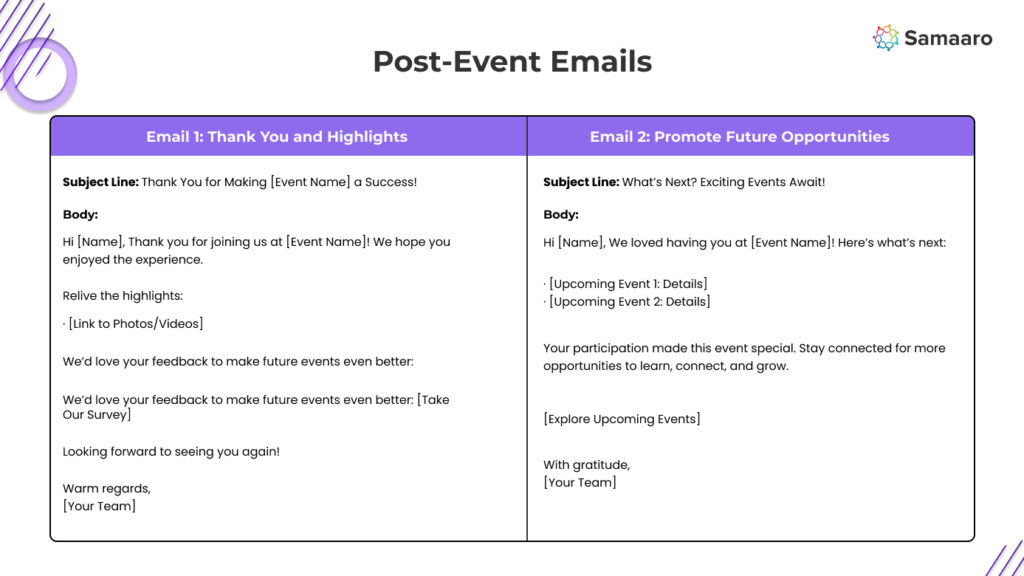
These trigger-based emails not only enhance the attendee experience but also ensure effective engagement throughout the event lifecycle.
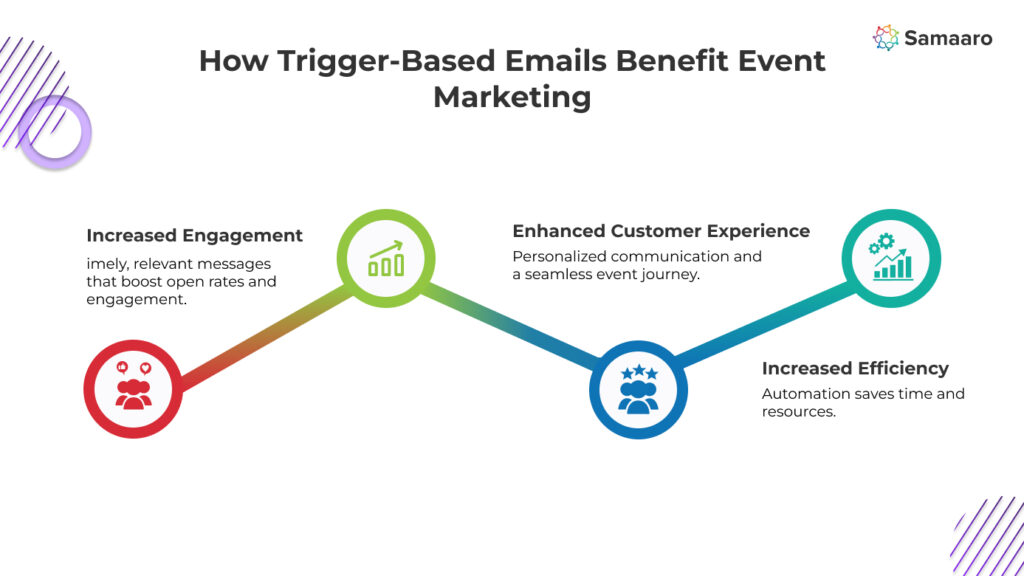
Trigger-based emails offer a range of advantages that make them indispensable for event marketers. Let’s dive deeper into their benefits:
One of the standout benefits of trigger-based emails is their ability to capture attention. These emails are sent in response to specific actions or behaviors, ensuring the message feels relevant to the recipient. When attendees receive an email shortly after registering, leaving their cart, or completing another action, they are more likely to open and engage with it.
How It Helps:
Trigger-based emails are a powerful tool for driving conversions. For instance, abandoned cart emails serve as a gentle reminder for prospective attendees who didn’t complete their ticket purchase. By addressing potential barriers—like confusion about pricing or last-minute hesitation—and offering solutions like discounts or extra perks, these emails help secure registrations that might otherwise be lost.
How It Helps:
Timely and personalized communication makes attendees feel valued. For example, a welcome email with all the essential details ensures attendees are well-prepared for the event. Similarly, a post-event email that thanks participants and shares highlights fosters a sense of appreciation and belonging.
How It Helps:
How It Helps:
Trigger-based emails rely on automation, which means your team can focus on higher-value tasks instead of manual follow-ups. Once workflows are set up, emails are sent automatically based on predefined triggers, ensuring consistent communication without extra effort.
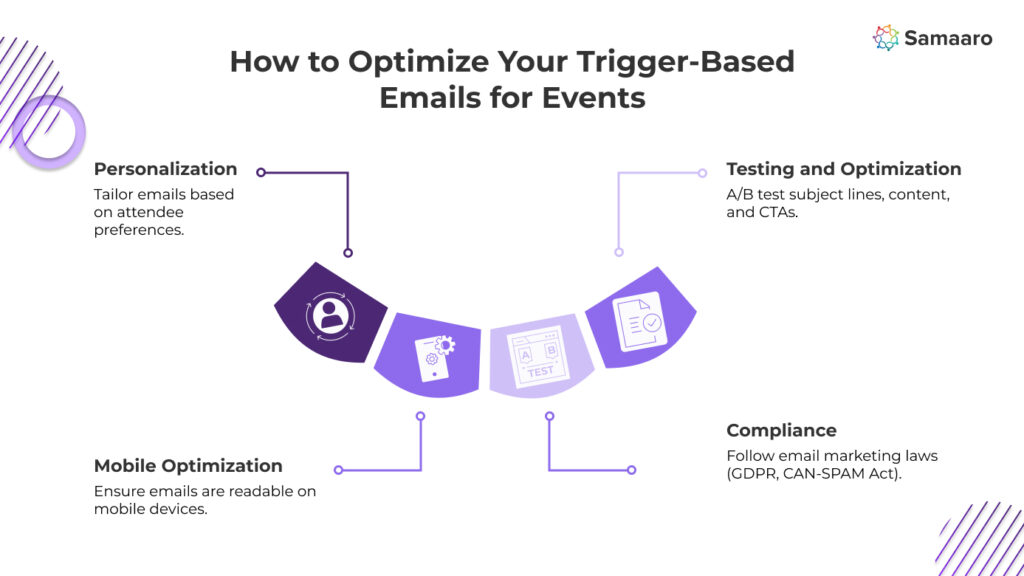
To maximize the effectiveness of trigger-based emails, it’s important to follow these best practices:
Personalization goes beyond adding the recipient’s name to an email. Leverage data to tailor the content to individual preferences and actions. For instance, include the specific ticket type they purchased or recommend sessions based on their interests.
Tips for Personalization:
In today’s mobile-first world, many recipients will open emails on their smartphones. If your emails aren’t optimized for mobile, you risk losing engagement and conversions.
How to Optimize for Mobile:
A/B testing is essential for refining your email campaigns. Experiment with different elements like subject lines, email layouts, imagery, and CTAs to identify what resonates best with your audience.
Testing Ideas:
Respecting privacy and adhering to email marketing regulations is critical. Failure to comply can lead to penalties and harm your brand reputation.
Key Compliance Tips:
Trigger-based emails are a game-changer in event marketing. Unlike traditional email campaigns, they are highly targeted, personalized, and action-driven, ensuring your audience receives the right message at the right time. From welcoming attendees to keeping them engaged post-event, these emails help marketers streamline communication and create a seamless attendee experience.
Why They Matter:
Get Started Today:
By implementing trigger-based email campaigns, you can elevate your event marketing strategy in 2025. Whether you’re a seasoned marketer or just getting started, platforms like Samaaro can help automate and personalize these campaigns, ensuring your event communication is both efficient and impactful.
Ready to transform your email marketing strategy? Dive into the world of trigger-based emails and watch your events thrive!
Connect with Samaaro today—book a demo or start your free trial to experience how our platform can help you craft and send personalized, automated trigger-based emails for your events.
Promoting events via social media is an important way to engage audiences. Regardless of if you are planning a corporate seminar, a product launch, or a music festival, social media should be part of your promotional toolkit. The reach and possibilities are incredible. With millions and millions of users spending multiple hours each week on social platforms such as Instagram, Facebook, TikTok, Twitter, and LinkedIn, the chances of an event reaching or engaging audiences is truly remarkable.
The advantages of a multi-pronged approach to social media should not go understated in 2025. Each social media platform provides content opportunities to uniquely defined audiences based on both demographics and content consumption preferences. If you have a content strategy that targets the various social media platforms, and specifically treats each platform differently, your event could be organized, fun, and event-worthy, leading to attendance and engagement with your event.
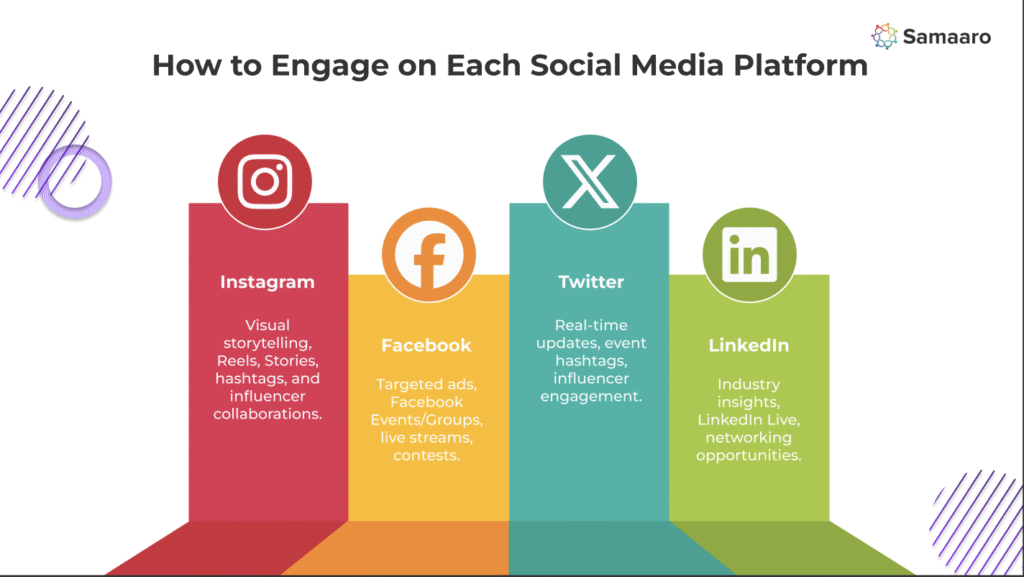
Instagram is the visual frontier. The ideal platform for displaying the pulse of your event by showcasing your unique energy.
Despite the emergence of more focused platforms, Facebook is still the major player with twenty-three percent (23%) of users aged fifty to seventy in 2025. It is a great option for creating discussions and promoting events to older audiences and allows businesses to target audiences based on their interests and profession.
Twitter is an excellent tool for real-time engagement and industry conversation.
The best use of LinkedIn is for professional or industry-focused events such as conferences, workshop offerings, or networking events.
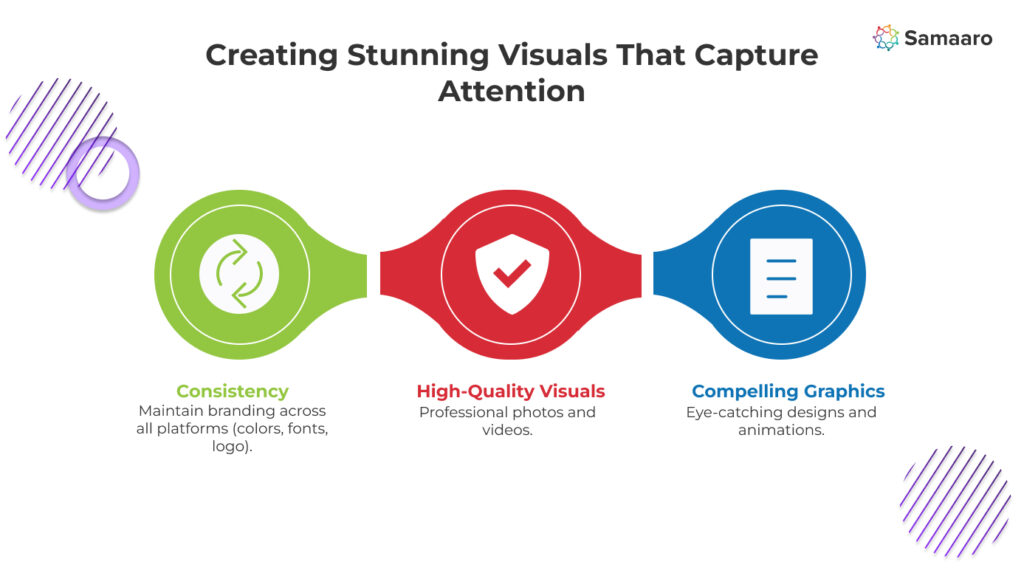
While not every organization will have access to or ability to invest in examples of professional quality visuals, to best achieve quality and expected quality for any/most types of event, Toby-rendered to his target demographics have generally assumed grants but do in offers, promotions of a good quality, strengths.
While not every organization will have access to or ability to invest in examples of professional quality visuals, to best achieve quality and expected quality for any/most types of event, Toby-rendered to his target demographics have generally assumed grants but do in offers, promotions of a good quality, strengths.
Event Highlights: Take high-quality pictures of key moments, speaker sessions, panel discussions, and audience interactions.Promotional Videos: Create clips and trailers of your event’s theme, past accomplishments, or what participants can expect.
Behind the Scenes Footage: Show unfiltered behind-the-scenes activity of your staff preparing for the event, it makes your brand human, and it gets people excited.
Live Action Shots: Photos of live activity, like networking or a product demo can help energize and connect with your content.
Visuals can be used to distill complex content and provide a more engaging experience.
Infographics: Use visuals as an effective means of conveying key data, event schedule, attendee demographics, etc.
Countdown Timers: Use countdowns to create urgency and excitement leading up to the event date.
Animated Content: Use animations in your event promotion to spotlight speakers, agenda items, or specials.
Interactive Graphics: You can engage your users with interactive content like polls or quizzes using visual content.
Having a consistent and cohesive visual identity is important for building brand recognition and trust.
Brand Guidelines: Be sure to follow your brand’s color palette, typography, and logo usage guidelines for visual content.
Templates: Use templates for repetitive material, such as event promotions or countdowns, etc. to create consistency.
Cross-Platform Adaptation: Make sure that your visuals are adapted to the platform.
For example:
Captions are your opportunity to help stop the scroll and catch your audience’s attention. An awesome caption does more than draw in viewers, it compels them to engage with your content and act. Here is how to develop great captions for your event promotion:
People love stories, so tell the story of your event. Illustrate your “why”; explain what’s special; or tell them how they remember the past events. For example,
“From a small idea over coffee to a global gathering of innovators; the journey has been amazing to get to #Event2025. Come be part of the story!”
“Last year, attendees made lasting connections and found defining ideas at . Who knows what we have planned for 2025? Come and find out!
Make your audience a part of the conversation with questions of wonder or fun. For example:
“What is one consideration you look for at an unforgettable event? We want to know what you think in the comments!”
“Who’s excited to experience ? Add a? if you’re coming!”
Providing some lightness and personality is a great way to humanize a brand. It makes you relatable. For example:
“Our lineup of speakers this year? Inspiration, innovation, and just the right amount of caffeine.?
“You + = Networking Heaven. See you there?”
Always tell your audience what they should do next. For example:
“Early Bird tickets have launched! Don’t wait. Book your tickets today at .”
“Follow us for live updates and exclusive sneak peeks behind the scenes as we prepare for the big day!”
When it comes to marketing your event, influencer marketing is no stranger to raise visibility and credibility of any event. Choosing the right influencer can positively impact your event attendance or engagement.
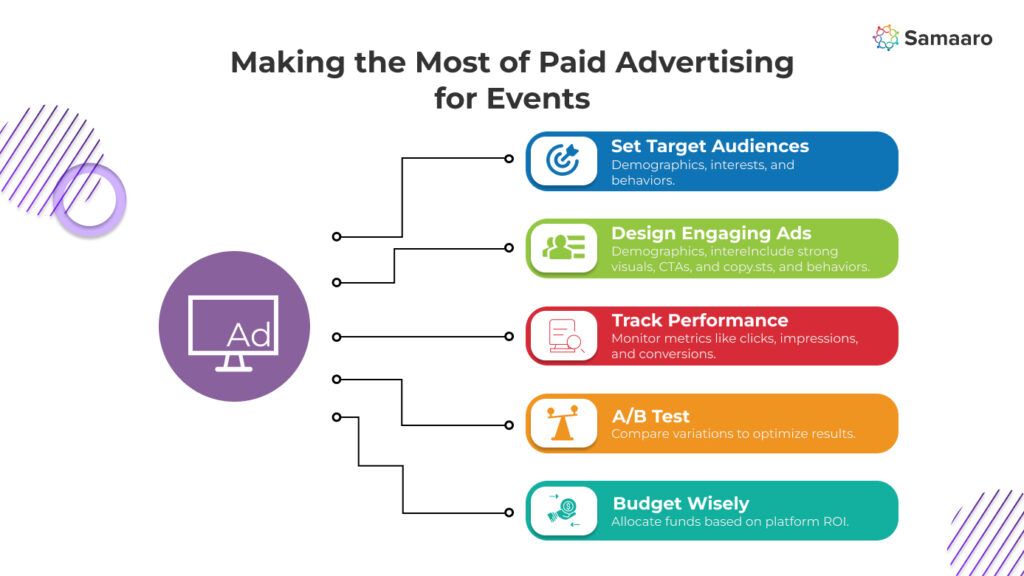
Paid social ads are extremely important when reaching larger audiences beyond your natural or organic audiences. When used effectively and strategically, they can deliver massive ROI and deliver event awareness.
Tailor your ads to the platform of choice:
Consider tracking through monitoring dashboards:
Be sure to keep optimising your ads that are not performing as expected to maximise your ROI.
Implementing more strategies surrounding captions, influencer marketing, and paid advertising will significantly drive the accomplishments of your event social media campaigns. Combining engaging content, influencer partnerships, and paid ads, means that your event will reach success and visibility through social media.
Just remember, social media plans are not static. You should always monitor your campaigns, track performance metrics, and adapt to ensure you continue to succeed. With the right approaches and tools, social media is a powerful medium to make your event truly unforgettable.
Let Samaaro, an AI-enabled event marketing platform, help you design and execute a social media strategy that works for you for your next event. Ask to demo today and start the process of creating impactful events!
Micro-events are becoming an increasingly common business event in the age of after-event engagement where experiences are recognized as stronger touchpoints for building relationships between brands and audiences. A micro-event is often a viable alternative to a large (and costly) conference or trade show. Micro-events are often smaller events where you can provide more personalization to guests based on their interests, which could promote a deeper connection between a brand and audience.
Micro-events are essentially a smaller way to engage your audience without the headache of planning and arranging for a large audience. Samaaro, an AI-powered event marketing platform provides event-led organizations with the ease to plan, execute, and measure micro-events. In this article, we will explore the advantages of micro-events, as well as, how to plan a micro-event that your guests will remember.
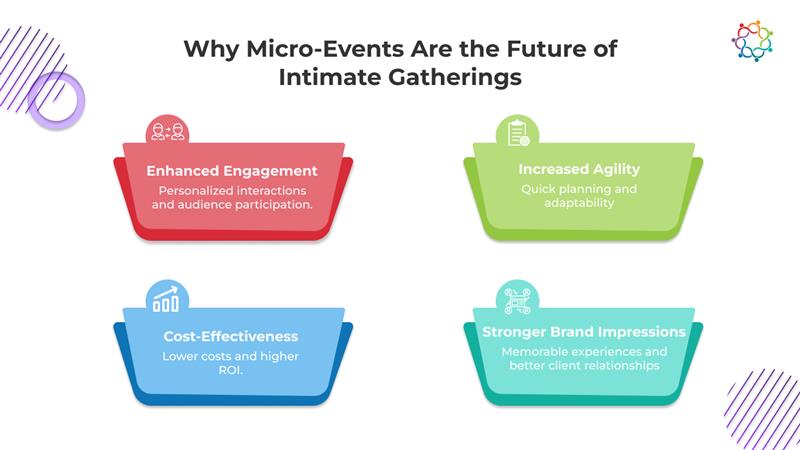
The first major benefit of micro-events is the ease of having better engagement in general. With fewer guests, you have a higher chance of having a genuine one-on-one interaction with attendees. When guests are in a smaller and friendlier atmosphere, they are much more likely to share their opinions, provide meaningful feedback, or engage in discussions either with the host or with other guests that could eventually lead to greater audience involvement and more significant opportunities, partnerships, or larger-scale sales or promotions.
Micro-events often involve a much lower cost compared to a larger conference or trade show. With a more selective guest list, costs related to venue rental, food and beverage, and tabling or event materials can all be lowered. With micro-events, the ability to be more selective with your guest list means your budget can be focused on your highest-value targets and a return on your investment. Using Samaaro’s target marketing and audience segmentation tools, you can be certain that your marketing efforts are directed at the most relevant prospects to maximize your ROI.
Another distinct advantage of micro-events is the enhanced flexibility they come with. Unlike large scale events, which take months of preparation, micro-events can usually be created and executed in a shorter time. A networking dinner? A product demonstration? Micro-events are suitable for smaller groups and both can be arranged to take place faster than the larger event. The smaller scale provides increased flexibility when making decisions and pivoting when necessary.
It’s widely accepted that micro-events offer more opportunities to create lasting brand impressions – because they are more personal and interactive, brands can demonstrate the product or service in a fuller and more engaging context. Attendees have stronger, and greater, connections to the brand, building loyalty and advocacy. Samaaro’s event marketing tools will also help you to create unique experiences that helped to differentiate your brand and leave a lasting impression!
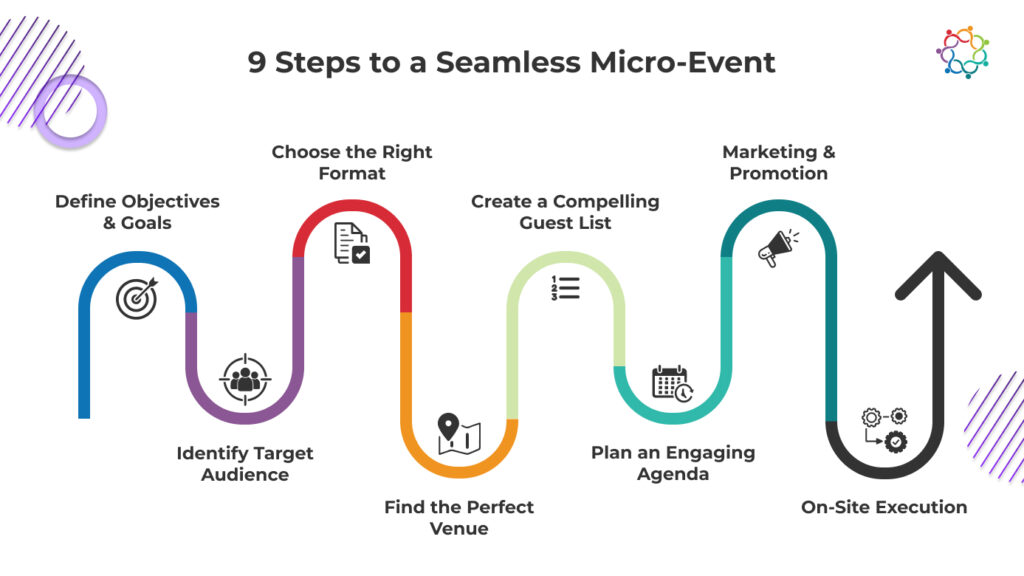
The first step to planning any successful event is to define your objectives. What do you hope to achieve from this micro-event? Each of these micro-events could involve networking opportunities, product launches, team-building events, and client appreciation, but your goals should also fit your business objective. Using the SMART framework of specific, measurable, but achievable, relevant and time-bound goals, let’s prepare some clear outcomes from the event.
Understanding your audience is important for the success of your micro-event. With a smaller audience, you should be more intentional with attendees that participate in your event. Who can benefit from your event? Potential clients? Influencers? Employees? Partners? Samaaro has audience segmentation tools with features that allow you to find the right invitees, people who are going to get the most value with the event.
Micro-events can take on several different forms, like intimate dinners, product demos, appreciation events or networking workshops, and your format should align with your goals. If your goal is to show off a new product, for example, this is best done through a hands-on demonstration, but if you are connecting with a few key clients, a private dinner would be much more appropriate. Samaaro helps you create the right event format for your objectives.
The venue is going to set the tone for your micro-event. Look for some intimate, unconventional venue that matches the spirit and scale of your event! Private residences, galleries, upscale restaurants and boutique hotels all represent good options for micro-events. Samaaro’s venue sourcing tools allow you to find the best fit for your gathering that fits your vision.
Guest lists matter with micro-events. Because the event is small, every person matters. When you are ready to manage your guests, use Samaaro’s CRM integration to manage your guests’ data, personalize your invite, and track RSVPs. It is also important to follow the steps to pick the right people who will add value to the event and align with your perfect attendee profile.
An engaging agenda will ensure your micro-event is a success. With a small group, there is an opportunity to have an agenda that engages and connects the group. You can add interactive events, discussions, or even surprise events. Think about what will engage your audience and create an unforgettable experience. Samrao can even assist in streamlining with tools for scheduling and managing attendance engagement with each event.
Despite being small, micro-events still demand promotional efforts. Indeed, all the communication tools in your marketing toolbox will help get people to attend your micro-event; personalized emails, promotional posts on social media, and emails directly asking to join the event will all entice your target audience. Samaaro has the marketing automation tools to design, set up, and execute well-targeted marketing campaigns to promote your event to new people with maximum exposure and reach. You can easily segment your audience to make sure that your messaging attracts the right attendees.
Event success often rests on executing a perfect event. You need to check-in guests, herd and manage a bunch of heads, direct foot traffic, and everything else should click together seamlessly. Samaaro’s event management product allows you to manage a small event on-site, and once you start, you only have to worry about the logistics for the event to go off without a hitch. Once the micro-event is over, Samaaro allows you to gather real-time feedback from attendees so you can action any improvements for the future.
Follow up after the event to continue to build on any relationships formed. Send your guests a personal email thanking them for attending, sharing some recognized events of the event, and following up with any leads or business opportunities. Samaroo provides analytics tools to gather valuable insights from your micro-event. You can gather your attendee engagement data and their general feedback to adjust and evolve your next engagement.
Micro-events are a great way to establish stronger relationships with potential clients and provide exciting brand experiences. By planning and executing smaller excited gatherings, companies can enhance engagement and brand impressions, while driving higher ROI. Samaaro has all our micro-event products to plan, market, and evaluate your micro-event ensuring there is impact and engagement.
Samaaro is a simple solution that can streamline the entire event process – audience segmentation, sourcing venues, event planning, marketing automation, and post event follow up. Interested in planning your next micro-event? Book a demo of Samaaro today and find out how we can help you plan successful high-impact events.
MICE events—Meetings, Incentives, Conferences, and Exhibitions—play a vital role in shaping business strategies, fostering connections, and driving growth. Whether it’s launching a product, nurturing client relationships, or celebrating employee achievements, MICE events are significant investments of time, effort, and money.
But how do you know if these events are truly delivering value? Measuring return on investment (ROI) for MICE events has become crucial to understanding their impact and aligning them with broader business goals. In this blog, we’ll explore key metrics for evaluating MICE event ROI and how Samaaro, an AI-powered event marketing platform, can help you turn data into actionable insights.
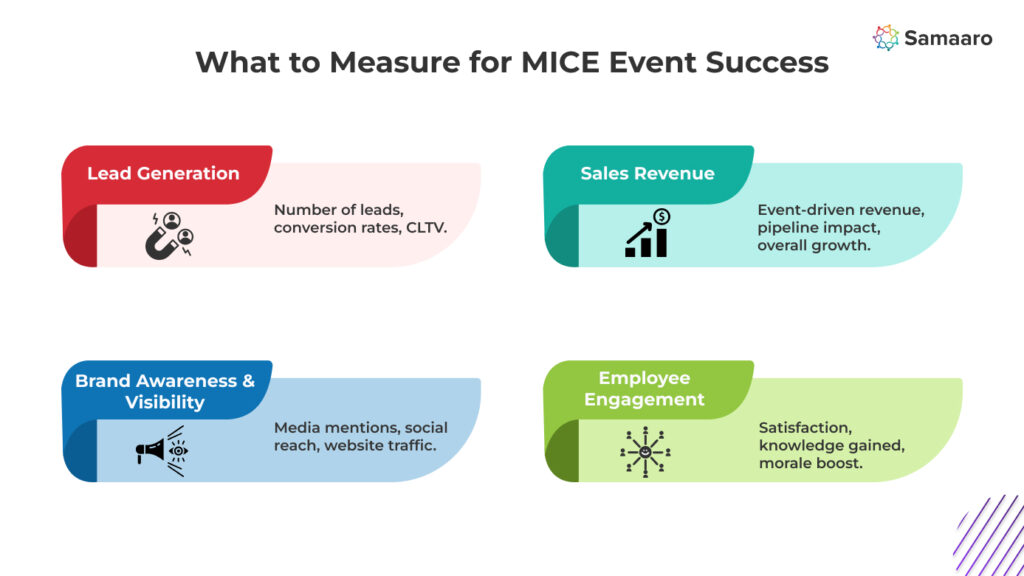
To evaluate the ROI of MICE events effectively, it’s essential to identify and track key performance indicators (KPIs) that reflect their success across multiple dimensions.
Lead generation is often a primary objective of MICE events. By capturing attendee information and nurturing them through the sales funnel, businesses can create long-term value. Key metrics to track include:
For most businesses, the ultimate measure of success lies in the revenue generated. Sales-related KPIs include:
MICE events are also powerful tools for amplifying brand presence. Consider tracking:
While external stakeholders are crucial, the internal impact of MICE events shouldn’t be overlooked. Track metrics like:
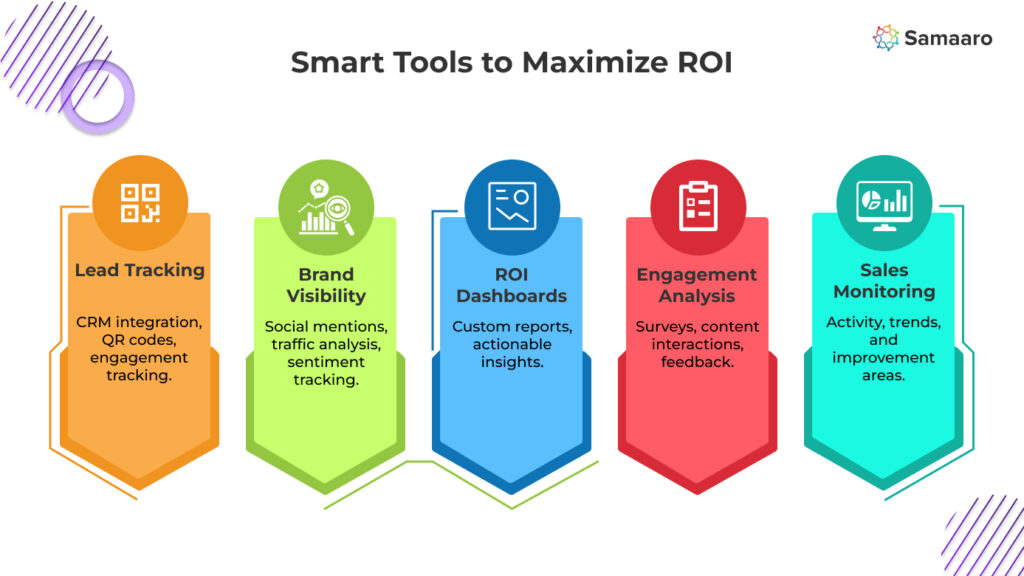
Measuring the return on investment (ROI) for MICE (Meetings, Incentives, Conferences, and Exhibitions) events is essential for assessing their success and justifying future investments. Samaaro, an AI-powered event marketing platform, offers a comprehensive suite of tools and integrations to simplify and enhance the ROI measurement process. Here’s how Samaaro helps you maximize the value of your events:
Effective lead management is a cornerstone of ROI measurement, and Samaaro ensures no lead goes unnoticed.
Understanding the sales impact of an event is vital to calculating its financial ROI.
Samaaro simplifies brand awareness tracking by consolidating multiple data sources into a single platform.
Attendee engagement is a critical indicator of an event’s success, and Samaaro excels in providing actionable insights.
Samaaro makes it easier to analyze and communicate event outcomes with intuitive reporting features.
One of Samaaro’s standout features is its ability to integrate with multiple tools, creating a unified system for measuring ROI.
Samaaro not only helps you measure MICE event ROI but also provides actionable insights to optimize your strategies for future events. By combining advanced technology with a user-friendly interface, Samaaro is your partner in achieving measurable, data-driven success.
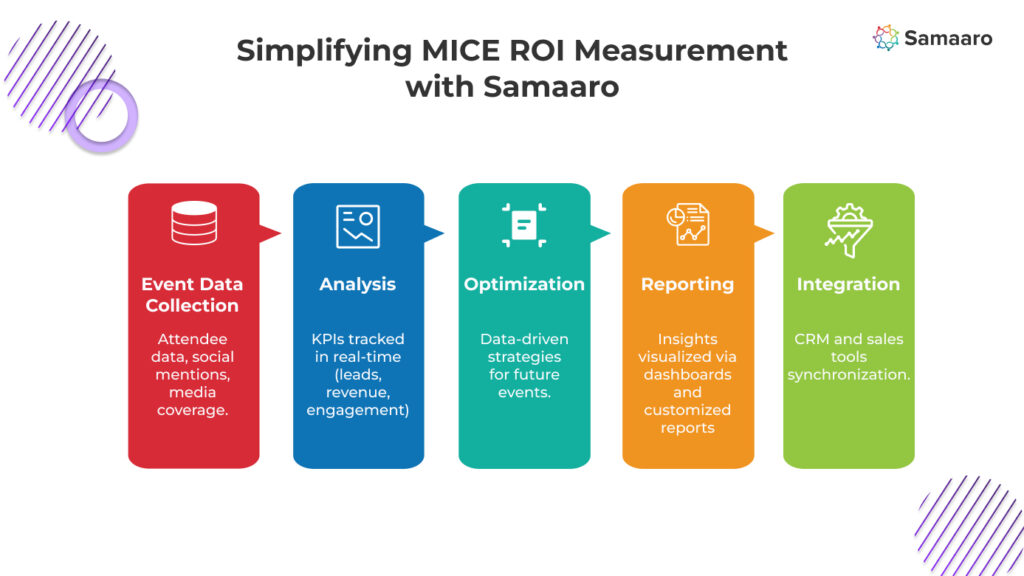
In today’s competitive landscape, MICE events are more than just networking opportunities—they’re strategic business tools. To maximize their value, measuring ROI isn’t optional; it’s a necessity.
By focusing on key performance indicators like lead generation, sales revenue, brand visibility, and employee engagement, event planners can understand their events’ true impact. Samaaro enhances this process by offering comprehensive tools to capture, analyze, and report on critical metrics, empowering businesses to make informed, data-driven decisions.
If you’re ready to take your MICE events to the next level, explore how Samaaro can simplify ROI tracking and optimize your event strategies. Schedule a demo today and start your free trial!
In order to promote their brands or organizations, many HNIs are willing to invest in events. They will use the opportunity to connect with the event’s target audience to increase brand awareness. These HNIs are willing to sponsor events that coincide with brand values or give back to the community in some way.
HNIs bring substantial financial backing, allowing event planners to create high-quality, impactful events without compromising on creativity or execution.
The association of a prominent individual with your event instantly boosts its reputation, helping attract a broader audience and more sponsors.
HNIs often have extensive networks of influential individuals and businesses. Their involvement can open doors to partnerships and future opportunities.
Unlike one-time sponsors, HNIs are more likely to invest in events they connect with, fostering enduring partnerships.
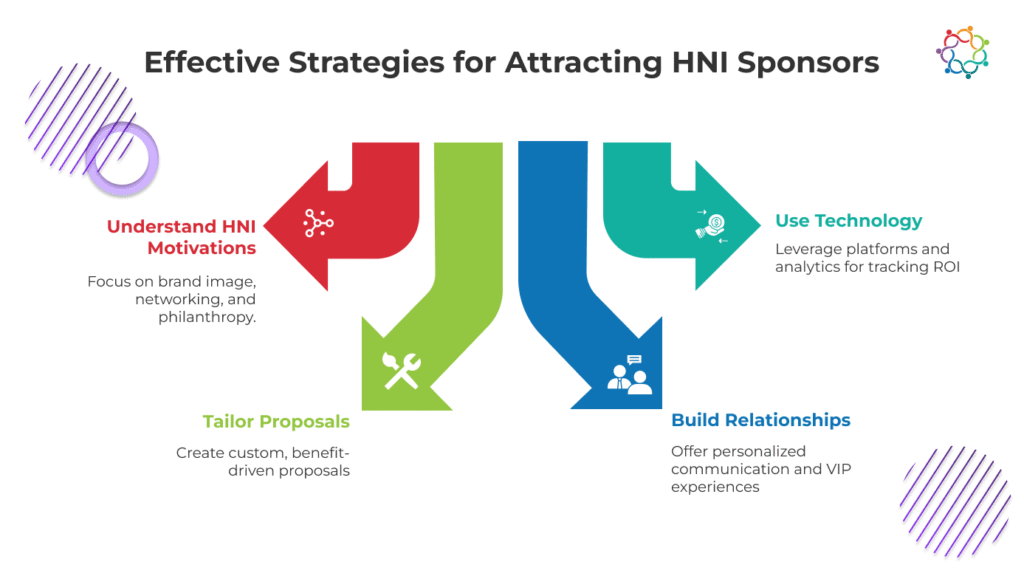
To effectively attract HNI sponsors, event planners must first understand what motivates them to invest in events.
HNI’s want to feel welcome and included in the pre-planning discussions with event organizers and supportives, not simply invited attendees and sponsors.
2. HNI Award Opportunities
HNI’s and all sponsors will appreciate the opportunity to sponsor an award recognizing an exceptional, local leader, or local organization in support of a program the event is part of, or the HNI can simply contribute an award to recognize an individual.
3. Philanthropic and Societal Impact
Many HNIs see philanthropy as a responsibility; therefore, connecting your event with philanthropy or societal initiatives will definitely make it more appealing to HNIs.
4. Tax Benefits
Another consideration is potential tax benefits related to sponsorships, which can also be highly attractive for HNIs from a financial perspective.
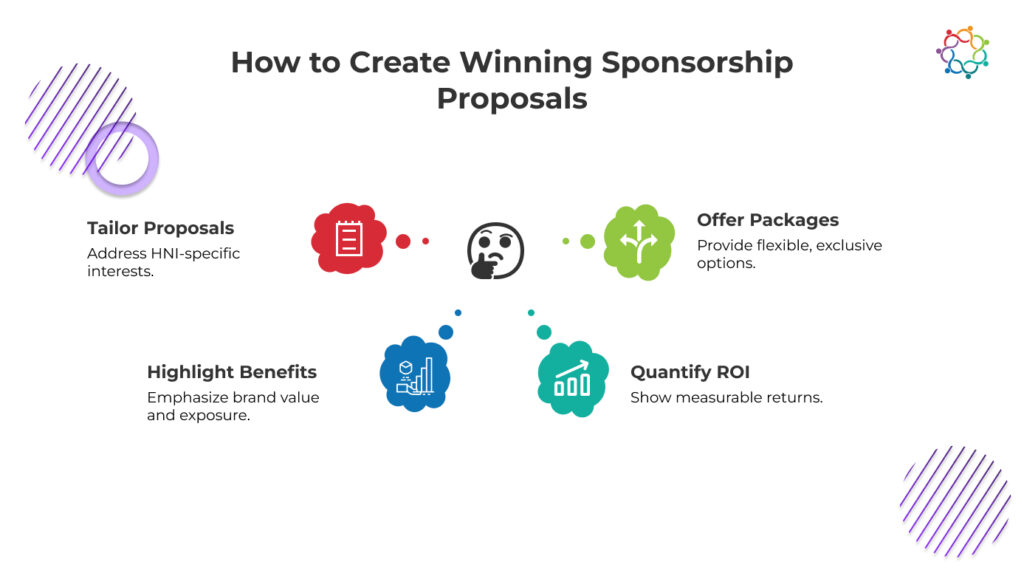
Should an HNI be convinced to sponsor an event, they will need to present a sponsorship proposal to their board of directors, or other approval committees. Good sponsorship proposals, proposals that present all necessary materials in the appropriate way proves to be important to engaging HNIs as sponsors.
1. Custom Proposals
One-size-fits-all sponsorship pitches will not engage HNIs. It is critical to know your HNI’s interests and prepare a proposal as customized to them, as possible and to ensure you address their interests and potential goals, values, and passions.
2. Benefits for the HNI
Any good sponsorship proposal needs to be explicit about the benefits and reasons a HNI would represent sponsors with their support, (for example, brand recognition, aligned with participation in a philanthropic initiative, leverage for network opportunities).
3. Estimate the ROI
HNIs partiality toward measurable projected results cannot be understated. Including measurable projections in sponsorship proposals reinforces evidence of correlation with sponsorship optioned engagement; this could be, audience data, demographics relatable to engagement data and social media impressions or reach estimates.
4. Creative Sponsorship Tiers
Create sponsorship tiers that include unique features for each tier:
Platinum: Unique sponsorship opportunities, access to VIP exclusive sections, engage with sponsors professionally; recognition by the event in advance.
Gold: Prominent opportunities for logo recognition, access to key event presentations, representation or acknowledgement in all promotional event materials.
Silver: Recognition only and complimentary free tickets, or informational material contained of their ‘visit’.
Establishing sponsorship is only the beginning of work. Maintaining the relationship with HNI sponsors is critical to long-term success.
1. Personal Communication
HNIs like individuality. Communicate in their style whether that is a more formal sponsorship proposal, a casual discussion or face-to-face meeting.
2. Unique Moments
HNIs value exclusivity. Provide them with perks such as backstage passes, private networking opportunities, or one-on-one time with the keynote speakers. This sets your event apart and makes the sponsorship more personal.
3. Follow Up After the Event
The relationship does not stop after the event. Send personalized thank you notes, share highlights from the event, and send a report back demonstrating the impact of their sponsorship. The goal is to have the HNI engage with you regularly for other opportunities.
Technology can make sponsorships easier, facilitate decision-making, and provide useful data.
2. Real-Time Analytics: You can show the instant impact of sponsorships with data. For example, tracking mentions, clicks, or audience interactions in the event and then reporting back to sponsors.
When working with HNIs, maintaining integrity is paramount.
Clear Communication: Be clear on what the sponsorship entails, both in terms of what they will receive and what they are expected to do. Ambiguity is generally unacceptable and can destroy the relationship.
Ethical Partnerships: It is unethical to have a conflict of interest. Ensure the HNI sponsor’s values align with the goal of the event and that it appeals to the audience.
Honour Commitments: Deliver on everything that you committed to in the sponsorship agreement. Whether that was branding, networking, or other perks, you need to deliver on those commitments if you want to build/reinforce trust.
Samaaro is event marketing platform that empowers event planners to attract, manage, and retain high-net-worth sponsors with ease. The platform allows you to create customized, data-backed sponsorship proposals, identify potential sponsors, and communicate seamlessly through personalized emails, automated follow-ups, and collaborative approvals. With Samaaro, you can demonstrate measurable ROI by tracking engagement metrics, social media mentions, attendee interactions, and brand exposure in real time, helping sponsors see the tangible impact of their investment.
Beyond proposals and analytics, Samaaro also streamlines sponsorship management by keeping contracts, deliverables, and perks organized, ensuring no commitment is missed. The platform enhances sponsor visibility across event apps, registration pages, email campaigns, social media, and on-site materials, while supporting multi-tiered sponsorships for events of any scale. By leveraging Samaaro, planners can deliver a professional, data-driven, and highly personalized experience that builds strong, long-term partnerships with HNI sponsors and maximizes event impact.
HNIs can change the game when it comes to event sponsorship. By understanding their motivations, developing attractive proposals, and building strong relationships, event planners will be able to secure valuable sponsorship partnerships that drive. Attracting high-net-worth individuals can take a little strategy, some dedication, and a personalized approach. The effort will be worth it.
If you are ready to take your sponsorship strategy to the next level, Samaaro is here for you. Go ahead and book a demo or start your free trial and see how our platform can help you secure valuable sponsorships and create amazing events!
In event planning, success often hinges on more than just creative ideas and flawless execution—it depends on the quality of partnerships formed along the way. Among these, the relationship with event vendors is critical. Vendors provide the goods and services that turn concepts into reality, from audiovisual equipment and catering to decor and transportation.
Strong vendor relationships not only ensure smooth event execution but also contribute to a higher-quality experience for attendees. Here’s how to build and maintain successful partnerships with event vendors to create memorable events.
Reliable vendors deliver high-quality services on time, minimizing last-minute hiccups and helping maintain the event’s reputation.
A strong relationship fosters open communication, making it easier to collaborate, troubleshoot, and adapt to changes.
Long-term partnerships often lead to cost savings through loyalty discounts, preferential treatment, and efficient workflows.
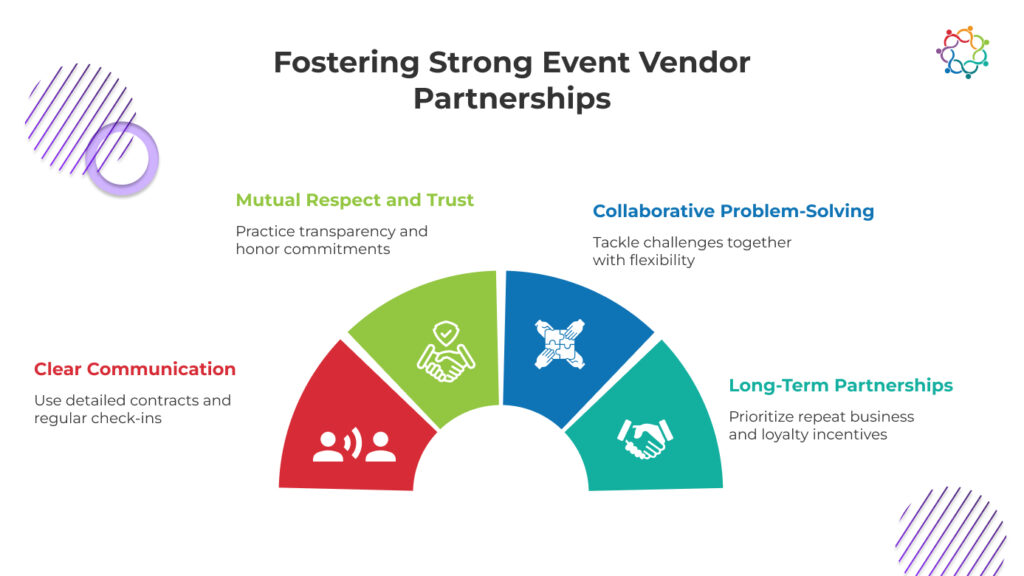
Effective communication is the cornerstone of any successful partnership.
Trust and respect are essential for any enduring partnership.
No event goes entirely according to plan, so being adaptable is key.
Strong, long-term relationships with vendors lead to consistency and trust over time.
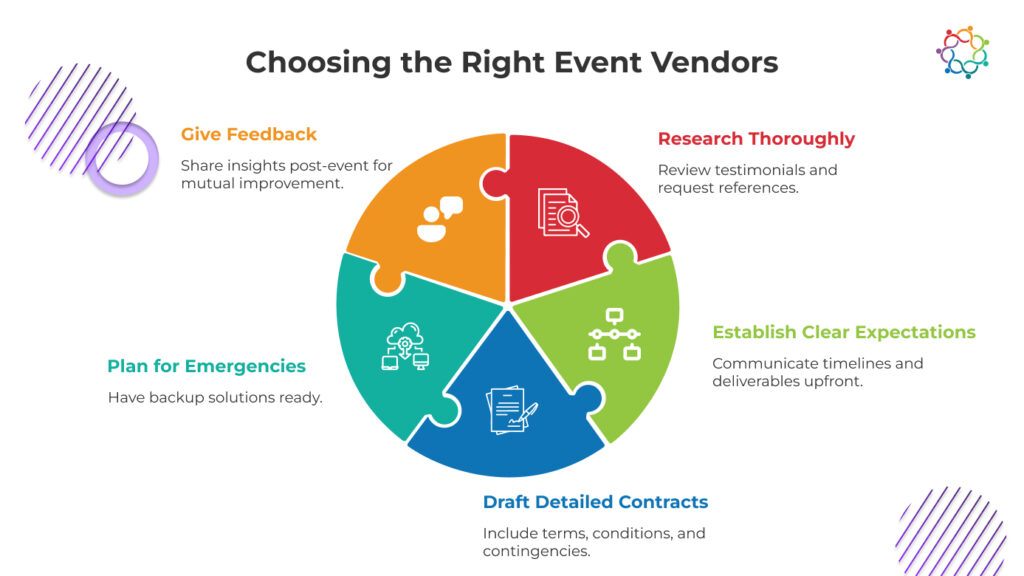
Before committing, research potential vendors to ensure they meet your needs.
A strong contract protects both parties and sets the foundation for a successful partnership. Include details like:
Events can be unpredictable, so always have a backup plan.
After the event, review vendor performance.
Event vendors are more than just service providers—they’re partners in your success. By building strong, respectful relationships, you can ensure seamless collaboration, deliver outstanding events, and foster loyalty that benefits both parties.
If you’re ready to take your event planning to the next level, Samaaro is here to help. Book a demo or start your free trial today, and discover how our platform can empower you to create exceptional events through seamless vendor collaboration.
In the ever-evolving world of marketing, events have become more than just gatherings; they’re pivotal touchpoints for engaging audiences, building brand awareness, and driving business growth. At the helm of these events is the event director—a professional whose role has shifted from logistical overseer to a strategic partner in marketing success.
Event directors are no longer confined to managing timelines and budgets. They are integral to crafting experiences that align with marketing objectives and amplify a brand’s message. Here’s a closer look at their responsibilities, challenges, and best practices to excel in this critical role.
Today’s event directors operate at the intersection of strategy, creativity, and execution. Their work directly impacts marketing outcomes, making them indispensable collaborators for marketing teams.

An event director’s journey begins with strategic collaboration.
Budgeting is a cornerstone of successful event planning.
A seamless event depends on reliable partners.
Effective event execution relies on cohesive teams.
Attention to detail is key to flawless execution.
Anticipating and addressing risks ensures event success.
The event director’s work doesn’t end when the lights go out.
Event directors must strike a balance between creating unique, memorable experiences and adhering to budgetary and logistical realities.
From marketing teams and clients to vendors and attendees, event directors juggle diverse expectations and ensure alignment among all parties.
Even the most meticulously planned events can face unforeseen hurdles, requiring quick thinking and adaptability.
Event directors must continuously evolve by adopting new technologies, trends, and best practices to stay competitive and relevant.

Clear communication ensures alignment and minimizes misunderstandings.
Using data to guide decisions enhances event outcomes.
Strong professional relationships are the backbone of successful events.
Staying ahead of the curve requires ongoing professional development.
Event directors rely on powerful tools to streamline planning and enhance impact. Samaaro, an all-in-one event marketing platform, provides solutions tailored to event professionals’ needs. From managing attendee data to tracking event performance, Samaaro empowers directors to focus on creating exceptional experiences.
The event director’s role is no longer limited to logistics; it’s a strategic position that drives marketing success. By mastering responsibilities, navigating challenges, and implementing best practices, event directors can create impactful events that align with business goals.
If you’re ready to elevate your event strategy, let Samaaro be your trusted partner. Book a demo or start your free trial today, and discover how Samaaro can help you achieve marketing success through exceptional events.
When the event is over, the dust has settled, and it is time to do the real work of evaluating how the event went. Was it a success in the eyes of the attendee? Did we generate valuable leads? Was what we received worth the investment? The answers are all in the metrics. When it comes to measuring the success of an event, it’s not just measuring the metrics. Rather, measuring events is about finding meaningful insights that will guide your future strategy.
Here is your useful guide to measuring the metrics that matter, how to measure the metrics, and what to do with the metrics to achieve better outcomes in event marketing.
Why Measuring Event Success Matters
Measuring your event metrics is much more than just proving the ROI of events, it helps you:
– Understand what worked: Identify positive aspects of your event so you can duplicate them for later events.
– Identify challenges: Find opportunities for growth to mitigate challenges for future events.
– Make data-driven decisions: Develop future strategy with real data and not based on assumptions or guesses.
– Prove value: Provide evidence of events value to stakeholders and substantiate for your event investment.
Key Metrics to Measure Event Performance
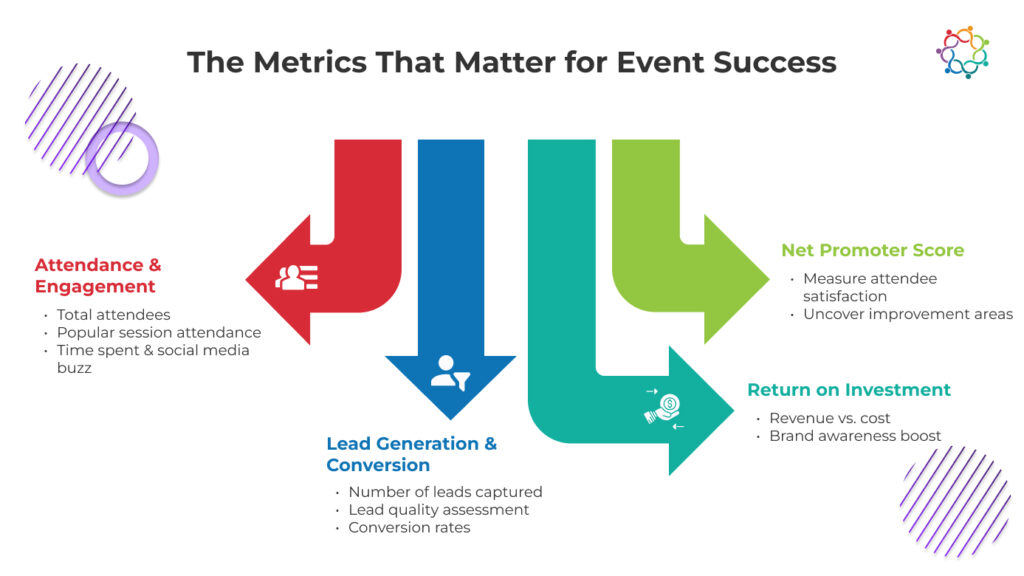
1. Attendance and Engagement Engagement metrics measures how well your event landed with attendees:
Total Attendee: A metric that demonstrates the reach of your event. If you have a goal of 300 attendees, compare the number of attendees to your previous event’s and strive for number indicates your events success.
Session Attendees: Tracking which sessions had the most attendees with indicate a preference in topics or speakers that had put on engaging talks or topics.
Time Spent: The longer attendees stay at your event, the more value they perceived of your offering. Use this as an indication of success.
Social Media Engagement: Track mentions, shares, hashtags and likes in social media channels. Strong engagement demonstrates that attendees were interested in being a part of the event and share their experience.
2. Lead Generation and Conversion
For many events, leads are the end goal at the end of the process. Use these measures to understand lead quality and conversion rates.
Leads generated: Count how many leads you captured at the event. This includes booth traffic, badge scans or information filled out during the event.
Lead quality: Not all leads are created equal. Segment leads by job role, size of company, purchasing authority or other factors that lets you focus on leads that are worth pursuing.
Conversion rate: This measure is the percentage of leads that engaged further down the sales funnel, meeting scheduled, demo completed, sale identified, etc.
3. Return on Investment (ROI)
ROI as a measure is one of the most important for proving value in your event.
Calculate ROI: Take total revenue generated and subtract total cost of the event, then divide by total event cost. Multiply by 100 to get the percentage.
Intangible returns: ROI is not just financial. Consider one value-add is brand awareness increased and/or strengthened customer relationships or increased employee team morale.
4. Net Promoter Score (NPS)
NPS is a popular measure of customer satisfaction and loyalty.
Measure satisfaction: Ask attendees ‘How likely to you recommend this event to someone else on a scale of 0-10?’
Analyzing Feedback: Assess the reasons for the scores to understand what thrilled participants as well as what could have improved.
Tools for Collecting and Analyzing Event Data
To track these metrics effectively, you’ll need the right tools.
1. Event Management Software
Event Marketing platforms, like Samaaro, provide an easy way to track attendance, session participation and lead generation real-time.
2. Analytics Tools
Google Analytics: Track website traffic and conversions related to your event.
Social Media Analytics: Measure social media reach and engagement using platform-specific insights or tools like Hootsuite.
Survey Tools: Use tools like SurveyMonkey to collect post-event feedback and calculate NPS.
3. CRM Software
Customer Relationship Management (CRM) software helps to manage leads and track your leads. CRMs that are compatible with your event management software have an integrated flow of data for follow up and reporting.
Best Practices for Measuring Event Success
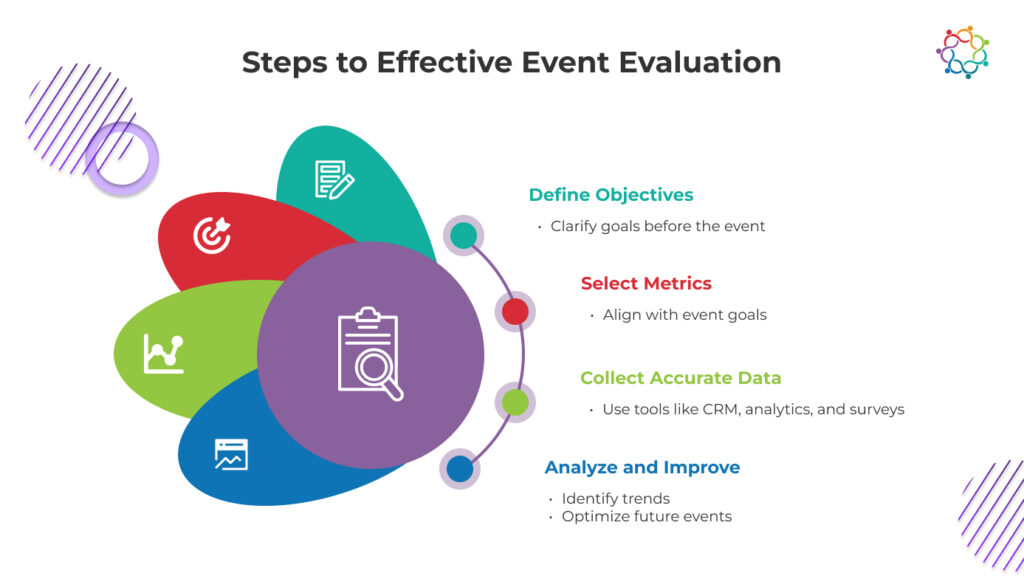
1. Set Clear Objectives
Prior to your event, you should set clear and specific goals such as the following:
– Increase attendance by 20%, from the previous year.
– Generate 200 qualified leads.
– Achieve a Net Promoter Score (NPS) of 80% or above.
2. Choose the Right Metrics
Always evaluate the metrics in relation to your goals. If lead generation is your main priority, then you will want to track metrics such as lead volumes, quality of leads or conversion rates.
3. Collect Accurate Data
Ensure that your collection of data is dependent on reliable methods. Attendee activity – tracking tools like QR code scanners, RFID badges, and event apps will guarantee you a verifiable recent history of the event.
4. Analyze Data Effectively
Post-event analyse the data to determine trends and insights. For example:
– What session had the highest attendance?
– Demographically, was there a large percentage of engagement?
– Which marketing channel had the highest number of registrations?
5. Continuously Improve
Use the takeaway in your data to enhance your next event, for example if your attendees enjoyed a speaker or format, use that again for the next event and be sure to improve upon any logistical issues.
Elevate Your Metrics Game with Samaaro
Measuring your event performance is easier when you have the right partner. Samaaro event marketing platform provides powerful analytics tools to track attendance, engagement and lead generation.
Samaaro integrates with your CRM and enables you to follow through with leads and report to stakeholders ultimately assessing the return on your investment.
Conclusion
Events are a large investment, therefore measuring for success or success through metrics is key to maximizing your return. When you focus on the appropriate metrics, such as attendance, engagement, perceived lead quality and ROI, then it will uncover actionable insights that drive continual improvements.
Data driven decision making might be a buzz phrase, but it’s the one skill that will allow for your events to be impactful but relevant for your business goals.
Are you ready to enhance your event marketing strategy? Try Samaaro for an improved flow for data collection and usability to drive actionable next steps. Book a demo or start your free trial today and see how metrics can drive your event success.
Events provide unparalleled opportunities for your sales team to connect with prospects, present products, and make sales. However, just showing up is not enough! You are expected to prepare to be successful, and getting your sales team prepared with the tools, training, and support they need to maximize their impact at the event is the key to success. And this is where sales enablement really matters.
By aligning preparation, technology, and strategy together you can prepare your sales team to turn any interaction into meaningful engagement opportunity. To help you with your successful sales enablement at the event, this ultimate guide has everything you need to prepare your team for success.
Sales enablement is more than just training, it’s about preparing your team with the tools and strategies to be successful. When your team is at events, where possibilities to take customers from ideas to a sale are limited in time and conclusive thought sales enablement becomes essential. It ensures your sales team is:
Informed: Familiar with everything product-related, what your competitors are doing, and what other trends are appearing in the marketplace.
Prepared: Provided with the tools, content, and strategy to handle whatever your customers attempted on their current experience.
Aligned: All your sales team members are on the same page regarding your event goal and what will or will not work for your business.
The result is a team that is confident and agile enough to capitalize on every customer conversation and opportunity at an event.

Preparation is the foundation of sales success. Equipping your team before the event ensures they arrive ready to deliver.
Events can be chaotic, but with proper on-site support, your sales team can remain focused and effective.
The event has not concluded when the doors close, what happens following it is equally significant. Effective follow-up moves the relationships built during the event into actual sales.

Define what success looks like for your sales team at the event.
Evaluate your team’s performance and the overall impact of the event.
Gather feedback from your sales team and attendees to identify areas for improvement.
Encourage your sales team to work together and share insights.
Sales enablement doesn’t have to be overwhelming. Tools like Samaaro, an event marketing platform, simplify the process by providing centralized resources and seamless integration with your sales workflow. From pre-event preparation to post-event follow-up, Samaaro empowers your sales team to succeed.
Event-based sales enablement is about more than just preparing your team; it is important to give your team everything it needs to be performing at its best at every opportunity. By putting a priority on training, tools and ongoing support, you will build a sales team that produces high-quality and quantity of performance.
When equipped with the right strategies and resources, your sales team can foster long-term relationships, create high-quality leads and drive successful event results.
Are you ready to rethink sales enablement? The solutions from Samaaro are designed to help elevate both event marketing as well as invest into sales teams. Play around with the demos or simply request a free trial to see how Samaaro can help with your event strategy.
Creating effective marketing materials is vital if you wish to have a successful event marketing campaign, as event marketing materials hook people into and entice them to engage with your content. The above event marketing materials include email invitations, printable flyer invitations, registration pages, and/or confirmation pages (after attendees register).
In this article, we’ll address how to create event marketing materials that transfer value to your audience and entice them to attend via compelling designs(aesthetics) and messaging.
In today’s competitive landscape, you need materials that are not only pretty, but that stand out in terms of value and messaging. The best marketing materials do the following:
– Articulate the value proposition of your event;
– Create a sense of urgency to register or attend;
– Promote brand recognition and then instil trust for your brand; &
– Build an anticipated audience that ultimately builds excitement and generates attendance.
Event marketing materials are often the first interaction a potential attendee has with your event. And, while you only get one chance to make a first impression, it always goes a long way.
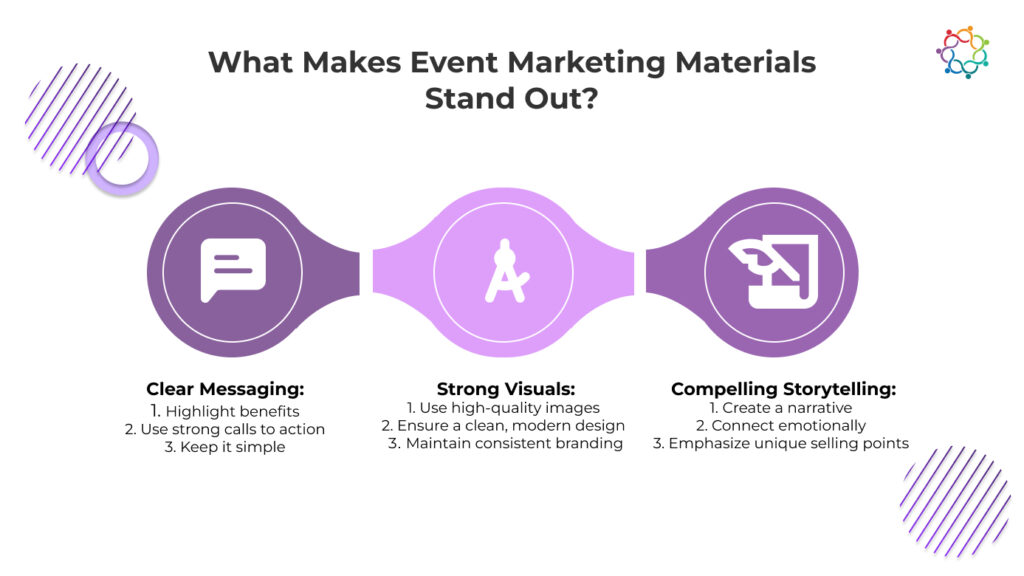
The messaging is the most important part of any good marketing material. Not everyone reads the entire page, because people are busy, so make sure to articulate your point, clearly, and succinctly.
– Identify Key Benefits: What benefit or offering will attendees receive from making the time to attend your event? Whether the audience regularly participates in your event or is attending for the first time, instil the factor of value – make the audience want to attend the event regardless.
– Call to Actions (CTA): Encourage the audience to take the next step – whether it is register, visit the website, or follow your tagged event page on social media.
– Keeping it Simple: Do not try to share too much information and overwhelm. Just cut to the chase and direct them to a website or a landing page that provides a lengthy description.
We are visual beings, and stunning design is one way to help create a memorable piece of marketing material.
People love stories; they help engage your audience in a way nothing else can. Craft the story to engage your audience.
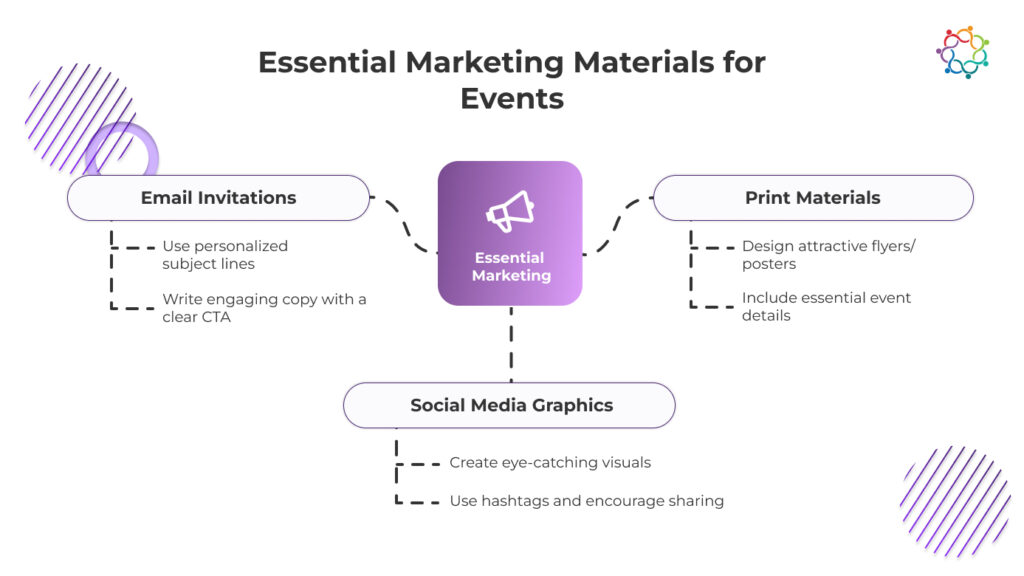
Email invitations are still one of the best ways to promote an event; however, email is an extremely busy place and getting someone’s attention in a moment of scrolling is not easy.
Social media is a great method to get people to buzz about your event. Make sure your graphics visually drive engagement through social.
Even if digital media outsources print material. Print still matters especially for more local events or high touch audience.
1. Know Your Audience
Effective marketing begins with understanding who you are speaking with. knowing where preferences are lie, pain prints reside or what they want to gain from the experience is equally important.
2. Test and revise
Don’t take your first draft as the final version. A/B Test different designs for graphics, headlines or CTAs to adjust your final materials that reflect your audience’s preference.
3. Measure Your Results
Follow up on how each part as it pertains to marketing your event works. Many times you are looking for open rates, engagement on social media or QR codes per material more generalized you can refine your next campaign!
4. Stay Consistent
Consistency with branding across marketing materials creates a complete and professional look that is simply consistent and can create trust overtime with your audience.
Engaging event marketing materials are the foundation of high-powered event marketing. When your event materials contain clear messaging, a strong visual, and an element of storytelling, your audience has no choice but to engage with your content.
Whether that is sending out evites, sharing in social or putting together print materials. As your creating always consider your audience and the process of when you select designs, materials, branding etc.
Get started today, book a demo or free trial today and let Samaaro assist with a easy process in creating impact marketing materials!

Built for modern marketing teams, Samaaro’s AI-powered event-tech platform helps you run events more efficiently, reduce manual work, engage attendees, capture qualified leads and gain real-time visibility into your events’ performance.
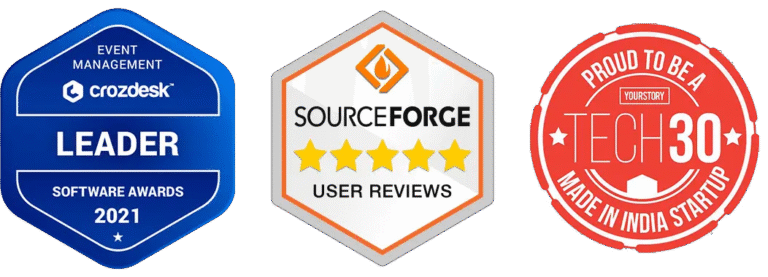
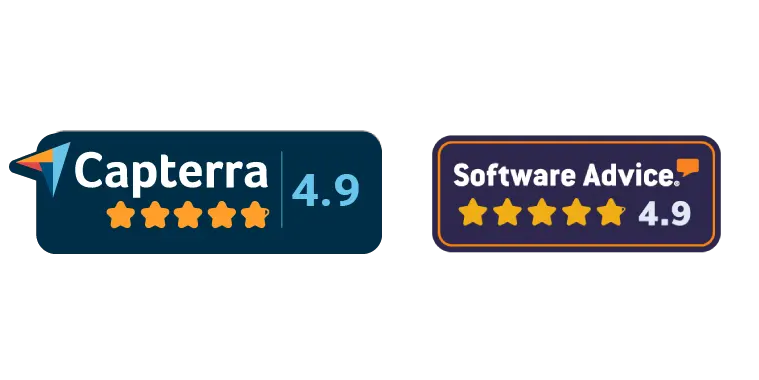
© 2025 — Samaaro. All Rights Reserved.